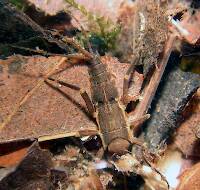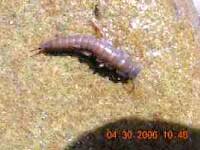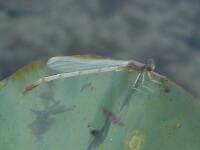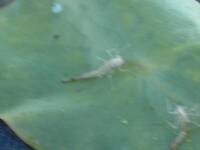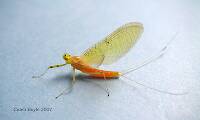
Blue-winged Olives
Baetis
Tiny Baetis mayflies are perhaps the most commonly encountered and imitated by anglers on all American trout streams due to their great abundance, widespread distribution, and trout-friendly emergence habits.
Featured on the forum

This one pretty clearly keys to Kogotus, but it also looks fairly different from specimens I caught in the same creek about a month later in the year. With only one species of the genus known in Washington, I'm not sure about the answer to this ID.

Troutnut is a project started in 2003 by salmonid ecologist Jason "Troutnut" Neuswanger to help anglers and
fly tyers unabashedly embrace the entomological side of the sport. Learn more about Troutnut or
support the project for an enhanced experience here.
QualityAqua has attached this picture to aid in identification. The message is below.

QualityAqua
Posts: 2
Posts: 2
QualityAqua on Jan 25, 2010January 25th, 2010, 1:12 am EST
Hello
I've found a very similar "insect" like the one in the pic in my tropical fish tank...
Can someone please help ID it and let me know if it is harmfull to the fish and plants and if so what is the best way to eradicate them?
NB: found the pic on another forum but it had no id...
Thanks in advance!
I've found a very similar "insect" like the one in the pic in my tropical fish tank...
Can someone please help ID it and let me know if it is harmfull to the fish and plants and if so what is the best way to eradicate them?
NB: found the pic on another forum but it had no id...
Thanks in advance!
Taxon on Jan 25, 2010January 25th, 2010, 3:40 am EST
QualityAqua-
The photo you posted from another forum is of a damselfly nymph. If the fish in your aquarium are as small or smaller than the nymph, it will likely eat them. On the other hand, if the fish in you aquarium are significantly larger that the damselfly nymph, one of them may eat it. If you don't want the damselfly nymph in your aquarium, either attempt removing it with an aquarium net, or just wait for it to reach nymphal maturity and emerge.
The photo you posted from another forum is of a damselfly nymph. If the fish in your aquarium are as small or smaller than the nymph, it will likely eat them. On the other hand, if the fish in you aquarium are significantly larger that the damselfly nymph, one of them may eat it. If you don't want the damselfly nymph in your aquarium, either attempt removing it with an aquarium net, or just wait for it to reach nymphal maturity and emerge.
QualityAqua
Posts: 2
Posts: 2
QualityAqua on Jan 25, 2010January 25th, 2010, 4:41 am EST
thanks for your reply taxon!
I caught one on Saturday. Sunday I found the largest guppy female (about 7cm) in the tank dead with a hole bored into its side... so I'm guessing theres more in there.
I'm catching all the fish out of that tank and removing all plants tonight and will then bleach the entire tank which I'm hoping will kill off any that are in there.
thanks again!
I caught one on Saturday. Sunday I found the largest guppy female (about 7cm) in the tank dead with a hole bored into its side... so I'm guessing theres more in there.
I'm catching all the fish out of that tank and removing all plants tonight and will then bleach the entire tank which I'm hoping will kill off any that are in there.
thanks again!
Taxon on Jan 25, 2010January 25th, 2010, 5:38 am EST
QualityAqua-
That doesn't sound to me like anything a damselfly nymph would do. Perhaps an aquatic beetle or waterbug. Is it possible for you to take a macro photo of the culprit, and share it with us? In any event, your plan seems sound.
That doesn't sound to me like anything a damselfly nymph would do. Perhaps an aquatic beetle or waterbug. Is it possible for you to take a macro photo of the culprit, and share it with us? In any event, your plan seems sound.
Quick Reply
Related Discussions
Topic
Replies
Last Reply
1
Jul 11, 2008
by Taxon
by Taxon
0
Aug 12, 2012
by Hdhungryman
by Hdhungryman
Re: Identification of a possible Cordulegaster Dragonfly Nymph
In Cordulegaster Dragonfly Nymph by IanB
In Cordulegaster Dragonfly Nymph by IanB
6
Feb 10, 2017
by Taxon
by Taxon



